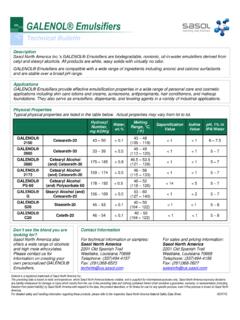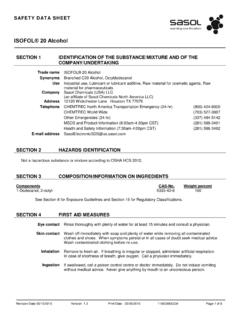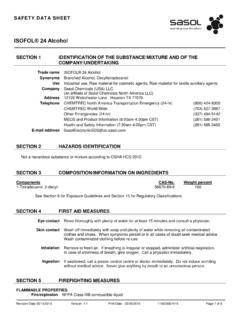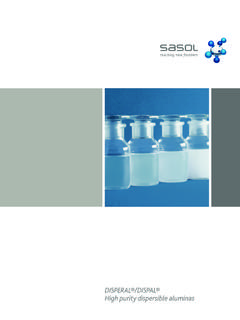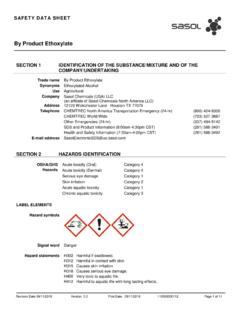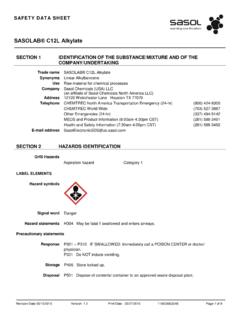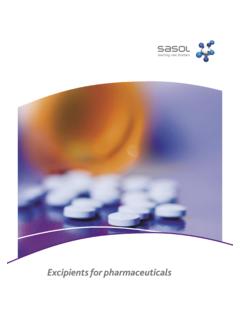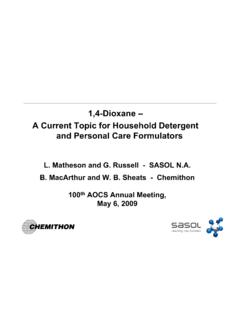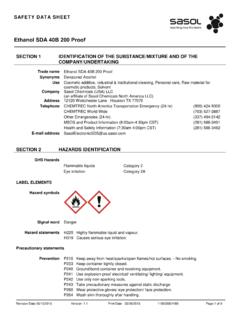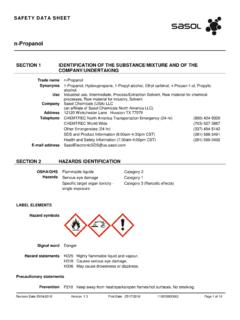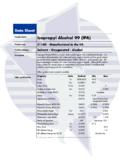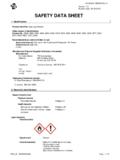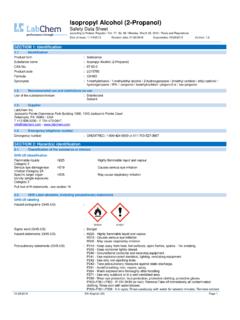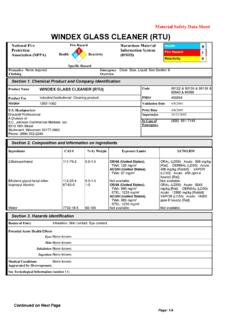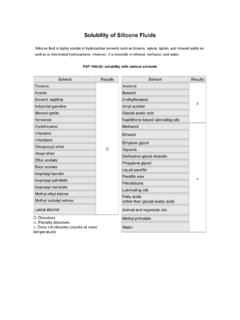Transcription of Isopropyl Alcohol - sasoltechdata.com
1 S AFETY DAT A SHEET. Isopropyl Alcohol SECTION 1 IDENTIFICATION OF THE SUBSTANCE/MIXTURE AND OF THE. COMPANY/UNDERTAKING. Trade name Isopropyl Alcohol Synonyms Dimethyl carbinol, Isopropanol Use Industrial use Company Sasol Chemicals (USA) LLC. (an affiliate of Sasol Chemicals North America LLC). Address 12120 Wickchester Lane Houston TX 77079. Telephone CHEMTREC North America Transportation Emergency (24-hr) (800) 424-9300. CHEMTREC World Wide (703) 527-3887. Other Emergencies (24-hr) (337) 494-5142. SDS and Product Information (8:00am-4:30pm CST) (281) 588-3491. Health and Safety Information (7:30am-4:00pm CST) (281) 588-3492. E-mail address SECTION 2 HAZARDS IDENTIFICATION. GHS Hazards Flammable liquids Category 2. Eye irritation Category 2A. Specific target organ toxicity - Category 3 (Narcotic effects). single exposure LABEL ELEMENTS.
2 Hazard symbols Signal word Danger Hazard statements H225 Highly flammable liquid and vapour. H319 Causes serious eye irritation. H336 May cause drowsiness or dizziness. Precautionary statements Prevention P210 Keep away from heat/sparks/open flames/hot surfaces. No smoking. P233 Keep container tightly closed. P240 Ground/bond container and receiving equipment. P241 Use explosion-proof electrical/ ventilating/ lighting/ equipment. P242 Use only non-sparking tools. Revision Date 08/19/2016 Version Print Date 08/19/2016 110000000932 Page 1 of 9. S AFETY DAT A SHEET. Isopropyl Alcohol P243 Take precautionary measures against static discharge. P280 Wear protective gloves/ eye protection/ face protection. P264 Wash skin thoroughly after handling. P261 Avoid breathing dust/ fume/ gas/ mist/ vapours/ spray. P271 Use only outdoors or in a well-ventilated area.
3 Response P303 + P361 + P353 IF ON SKIN (or hair): Remove/ Take off immediately all contaminated clothing. Rinse skin with water/ shower. P370 + P378 In case of fire: Use water spray, Alcohol -resistant foam, dry chemical or carbon dioxide for extinction. P305 + P351 + P338 IF IN EYES: Rinse cautiously with water for several minutes. Remove contact lenses, if present and easy to do. Continue rinsing. P337 + P313 If eye irritation persists: Get medical advice/ attention. P304 + P340 IF INHALED: Remove victim to fresh air and keep at rest in a position comfortable for breathing. P312 Call a POISON CENTER/doctor if you feel unwell. Storage P403 + P405 + P235 Store locked up in a well-ventilated place. Keep cool. SECTION 3 COMPOSITION/INFORMATION ON INGREDIENTS. Components CAS-No. Weight percent 2-Propanol 67-63-0 100. See Section 8 for Exposure Guidelines and Section 15 for Regulatory Classifications.
4 SECTION 4 FIRST AID MEASURES. Eye contact Rinse thoroughly with plenty of water for at least 15 minutes and consult a physician. Skin contact Wash off immediately with soap and plenty of water while removing all contaminated clothes and shoes. When symptoms persist or in all cases of doubt seek medical advice. Wash contaminated clothing before re-use. Inhalation Remove to fresh air. If breathing is irregular or stopped, administer artificial respiration. In case of shortness of breath, give oxygen. Call a physician immediately. Ingestion If swallowed, call a poison control centre or doctor immediately. Do not induce vomiting without medical advice. Never give anything by mouth to an unconscious person. SECTION 5 FIREFIGHTING MEASURES. FLAMMABLE PROPERTIES. Fire/explosion Vapours may form explosive mixture with air. Flash back possible over considerable distance.
5 Use water spray to disperse the vapors. NFPA Class 1B flammable liquid. Suitable Use water spray, Alcohol -resistant foam, dry chemical or carbon dioxide. Revision Date 08/19/2016 Version Print Date 08/19/2016 110000000932 Page 2 of 9. S AFETY DAT A SHEET. Isopropyl Alcohol extinguishing media Protective equipment In the event of fire, wear self-contained breathing apparatus. and precautions for firefighters Further information Keep containers and surroundings cool with water spray. Beware of vapours accumulating to form explosive concentrations. Vapours can accumulate in low areas. SECTION 6 ACCIDENTAL RELEASE MEASURES. Methods and Evacuate personnel to safe areas. Remove all sources of ignition. Contain spillage, and materials for then collect with non-combustible absorbent material, ( sand, earth, diatomaceous containment and earth, vermiculite) and place in container for disposal according to local / national cleaning up regulations (see section 13).
6 Do not flush into surface water or sanitary sewer system. SECTION 7 HANDLING AND STORAGE. Safe handling advice Ensure all equipment is electrically grounded before beginning transfer operations. Keep away from heat and sources of ignition. Storage/Transport Ambient pressure Load/Unload Ambient temperature SECTION 8 EXPOSURE CONTROLS/PERSONAL PROTECTION. ENGINEERING MEASURES. Air contaminant levels should be controlled below the PEL or TLV for this product (see Exposure Guidelines). Ensure adequate ventilation, especially in confined areas. Use explosion-proof equipment. PERSONAL PROTECTIVE EQUIPMENT. Eyes Chemical resistant goggles must be worn., Face-shield Skin Wear suitable protective clothing, gloves and eye/face protection. Inhalation Respiratory protection is normally not required except in emergencies or when conditions cause excessive airborne levels of mists or vapors.
7 Use NIOSH approved respiratory protection. EXPOSURE GUIDELINES. Components Exposure limit(s). 2-Propanol OSHA PEL 400 ppm 980 mg/m3. ACGIH TLV (8-hour) 200 ppm ACGIH STEL 400 ppm Revision Date 08/19/2016 Version Print Date 08/19/2016 110000000932 Page 3 of 9. S AFETY DAT A SHEET. Isopropyl Alcohol PEL= Permissible Exposure Limits TWA= Time Weighted Average (8 hr.). TLV= Threshold Limit Value STEL= Short Term Exposure Limit (15 min.). EL= Excursion Limit WEEL= Workplace Environmental Exposure Level SECTION 9 PHYSICAL AND CHEMICAL PROPERTIES. Appearance liquid;. Colour Clear, colorless Form liquid Odour Alcohol -like Odour Threshold no data available Flash point 13 C, 55 F;. Flammability Upper explosion limit: 19 %(V). Lower explosion limit: %(V). Boiling point/boiling 82 C, 180 F;. range Melting point/range -92 C, -134 F;. Auto-ignition 363 C, 685 F.
8 Temperature Decomposition no data available temperature Flammability (solid, no data available gas). Vapour pressure no data available Vapour density no data available Density g/cm3 @ 20 C, 68 F;. Specific gravity no data available Water solubility completely miscible Viscosity no data available Viscosity, dynamic no data available Revision Date 08/19/2016 Version Print Date 08/19/2016 110000000932 Page 4 of 9. S AFETY DAT A SHEET. Isopropyl Alcohol pH 7. Evaporation rate no data available Partition coefficient: n- no data available octanol/water Volatile organic 100 %. compounds (VOC). content SECTION 10 STABILITY AND REACTIVITY. Reactivity No decomposition if stored and applied as directed. Chemical stability Stable under recommended storage conditions. Conditions to avoid Heat, flames and sparks. Avoid temperatures above 35 C, direct sunlight and contact with sources of heat.
9 Hazardous Combustion products include carbon dioxide, carbon monoxide and possibly other decomposition unidentified organic compounds. products Materials to avoid Strong acids and oxidizing agents Acid anhydrides Aluminium Halogenated compounds Hazardous Vapours may form explosive mixture with air. polymerisation SECTION 11 TOXICOLOGICAL INFORMATION. Acute dermal toxicity LD50 Rabbit: > 2,000 mg/kg(literature value). Acute inhalation LC50 Rat (8 hours): > 20 mg/l toxicity (literature value). Acute oral toxicity LD50 Rat: > 2,000 mg/kg (literature value). Skin (Rabbit). corrosion/irritation Not irritating, (literature value). Eye damage/irritation (Rabbit). irritating, (literature value). Respiratory or skin Guinea pig: not sensitizing; Buehler Test sensitization (literature value). Germ cell mutagenicity Genotoxicity in vitro: Revision Date 08/19/2016 Version Print Date 08/19/2016 110000000932 Page 5 of 9.
10 S AFETY DAT A SHEET. Isopropyl Alcohol Type: Ames test System: Salmonella typhimurium; with and without metabolic activation Result: In vitro tests did not show mutagenic effects (literature value). Genotoxicity in vivo: no data available Assessment Mutagenicity: Based on available data, the classification criteria are not met. Reproductive toxicity Reproductive toxicity: no data available Assessment Reproductive toxicity: no data available Teratogenicity: no data available Assessment teratogenicity: no data available STOT - single The substance or mixture is classified as specific target organ toxicant, single exposure, exposure category 3 with narcotic effects. STOT - repeated Rat; Oral; 90-day;. exposure NOAEL: 1,730 mg/kg LOAEL: 3,160 mg/kg Based on available data, the classification criteria are not met. Aspiration toxicity no data available Carcinogenicity Assessment carcinogenicity: Contains no ingredient listed as a carcinogen SECTION 12 ECOLOGICAL INFORMATION.
